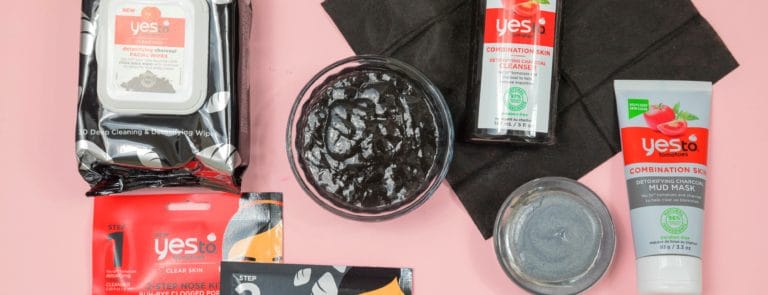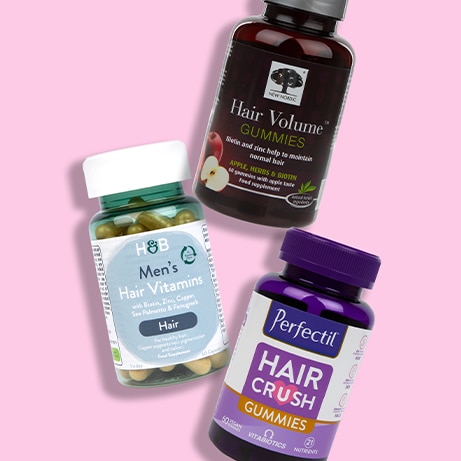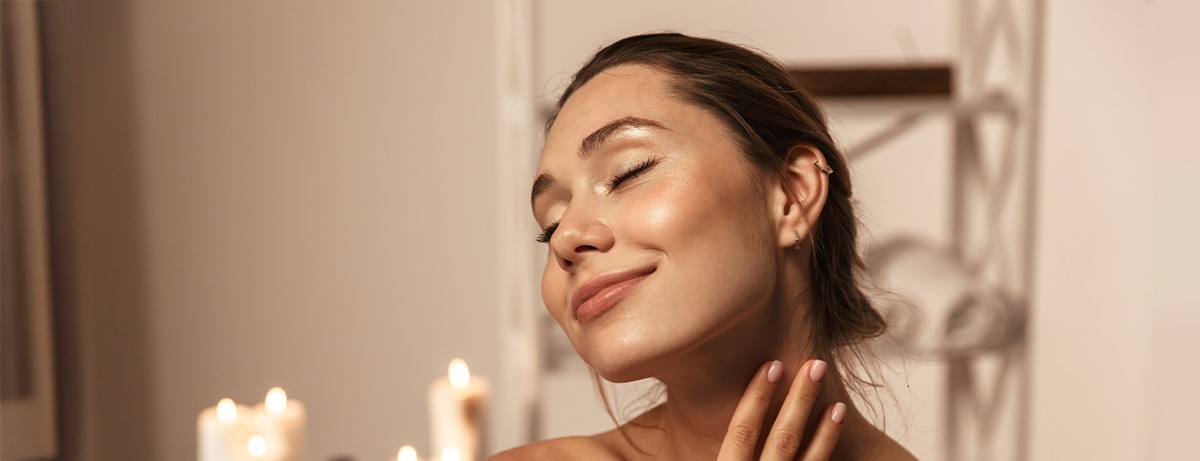15% off £25 or 20% off £35
Code:BASKET
Rosacea: causes, symptoms and treatments

From identifying the tell-tale redness to understanding treatments, discover how to tackle this common yet often misunderstood skin condition with confidence
Summary
1What’s rosacea?
Rosacea is a long-term skin condition that primarily affects the face, causing redness, visible blood vessels and sometimes acne-like bumps…
2Who gets rosacea?
Rosacea has a way of showing up uninvited, especially in people aged 30–50…
3What causes rosacea?
While the exact cause remains unknown, researchers have uncovered a mix of genetic, environmental and lifestyle factors…
Feeling rosy-faced for all the wrong reasons? Rosacea, a condition often mistaken for persistent blushing, can leave you wondering what’s happening beneath the surface.1
Whether it’s the flare-ups sparked by a glass of red wine or the warmth of a sunny afternoon, navigating rosacea can feel like unravelling a web of triggers and mystery.1 But don’t worry – we’re here to help you crack the code and restore balance to your skin.
What’s rosacea?
Rosacea is a long-term skin condition that primarily affects the face, causing redness, visible blood vessels and sometimes acne-like bumps.2
It’s not contagious and tends to come and go, with flare-ups often linked to specific triggers.1 While it’s more common in fair-skinned individuals, rosacea can affect anyone.3
What sets rosacea apart from other skin concerns is its connection to inflammation and blood vessel abnormalities.4 If you’ve ever wondered why your cheeks flush so easily or why redness stubbornly lingers long after you’ve cooled down, rosacea could be the answer.
Who gets rosacea?
Rosacea has a way of showing up uninvited, especially in people aged 30–50.3 It’s a little more common in women, but men may experience more severe symptoms.1
Family history also plays a role – if someone in your family has rosacea, your risk of developing it may be higher.3
While lifestyle habits and environmental factors can trigger a rosacea flare-up, your nutrition may play a part too.5,6 Although rosacea’s more commonly reported in people with fair skin, it can affect people of all skin tones, including those with darker complexions, where it may often go unrecognised or misdiagnosed.1,7
What causes rosacea?
While the exact cause remains unknown, researchers have uncovered a mix of genetic, environmental and lifestyle factors that team up and make their mark.1,3
Here’s what they’ve pieced together so far:
- immune system overactivity: think of your immune system as an overzealous cheerleader – sometimes, it just goes overboard, leading to redness and inflammation8
- skin mites: yes, we all have tiny Demodex mites on our skin. While they’re harmless, an increase in their numbers has been linked to rosacea flare-ups 9,10
- environmental triggers: the sun or extreme temperatures can be troublemakers, transforming a regular day out into a rosacea-triggering event 1,3
- lifestyle factors: spicy foods, alcohol and stress are common culprits when it comes to rosacea flare-ups.1 While a piping hot cup of tea or coffee might heat things up temporarily, it’s not all bad news – research suggests that the caffeine in coffee could actually help lower the risk of developing rosacea in women11
Rosacea doesn’t have a one-size-fits-all cause, but knowing these potential triggers can help you manage those unwelcome flare-ups.
Rosacea symptoms
Rosacea symptoms can vary, but here are some of the most common signs to keep on your radar:1-3
- persistent redness: this often appears across your cheeks, nose, forehead or chin, lasting a couple of minutes before calming down
- flushing episodes: these come with an unwelcome warm or hot sensation, like your skin’s turning up the thermostat
- visible blood vessels: known as telangiectasia, these fine red lines may appear when your blood vessels decide to take centre stage
- acne-like bumps and pimples: these spots might resemble typical breakouts but are linked to rosacea
- eye irritation (ocular rosacea): red, watery or gritty eyes are a lesser-known symptom of rosacea, but one that’s just as important to recognise
- thickened skin: in rare cases, the skin around the nose can become thicker and bumpy (rhinophyma)
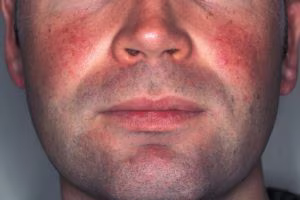
What does rosacea look like?
Rosacea often begins with a tendency to blush or flush more quickly than most, which might seem harmless at first.1 For some, the redness starts as a small patch on one cheek or another part of the face.1 Some people might also notice acne-like bumps, while others experience extra sensitivity, dryness or irritation.1,3
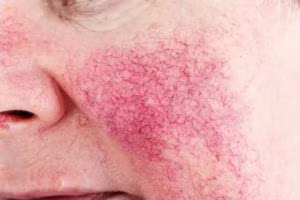
Over time, this redness may spread to other areas of the face and become more persistent, often accompanied by visible blood vessels.2
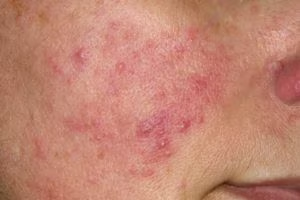
In some cases, rosacea symptoms appear symmetrically, affecting both sides of the face.12 In more severe cases, the skin can thicken and develop a bumpy texture, particularly around the nose.3
Rosacea treatment
While there’s no magic wand to cure rosacea, there are plenty of treatments that can help you take control, ease symptoms and reduce pesky flare-ups.3 Here’s how to get started:
When managing rosacea, your skincare routine is your first line of defence. The right products and gentle habits can help soothe your skin, strengthen its barrier and minimise flare-ups. The following strategies can help give your skin the TLC it deserves:3,13,14
- gentle cleansing: use mild, fragrance-free cleansers to avoid irritating your skin
- keep hydration in focus: lightweight moisturisers are your best friends for strengthening your skin’s barrier
- sunscreen is non-negotiable: protect your skin daily with mineral-based SPF containing zinc oxide or titanium dioxide (SPF 50 or higher)
Your lifestyle choices could have a significant impact on rosacea flare-ups. Small adjustments to reduce stress, avoid common triggers and make mindful decisions can go a long way in keeping your skin happy.1
Here are a few tips to try:1,15
- relax and reset: stress management techniques such as yoga or meditation could make a difference
- mind your diet: spicy foods, hot drinks and too much alcohol may all stir up trouble
For more stubborn symptoms, medical treatments prescribed by a healthcare professional can offer a helping hand.
From prescription creams to advanced therapies, the following options may help reduce redness and inflammation:16
- topical treatments: prescription creams like ivermectin, metronidazole or azelaic acid may help soothe redness, inflammation and papules. Brimonidine gel may also provide temporary relief for stubborn redness, often starting to work within 30 minutes and reaching its peak effect after about 3–6 hours
- oral medications: if your symptoms are more severe, antibiotics such as doxycycline, or alternatives like oxytetracycline or erythromycin, may help calm things down from the inside out
- laser or light therapies: for those visible veins or persistent redness, advanced treatments like intense pulsed light (IPL) or pulsed dye laser might help make a noticeable difference
- eye care: got ocular rosacea? Artificial tears or lubricants can help ease irritation, and keeping your eyelids clean with gentle hygiene is a must. If symptoms persist, your GP may refer you to an ophthalmologist for specialised care
Sometimes, simple at-home solutions can make a noticeable difference. These easy remedies might help soothe your skin and keep flare-ups in check:17
- cool compresses: a damp cloth or cold pack can instantly help relieve redness
- aloe vera gel: its natural calming properties may help soothe inflammation
- green tea masks: a soothing green tea mask could have a positive effect on your rosacea
If you’re unsure which treatment’s best for you or if your symptoms feel unmanageable, consult a healthcare professional. They can offer personalised advice and recommend the best treatment course for your skin.
Living with rosacea
Managing rosacea’s a marathon, not a sprint. Here are some practical tips for keeping symptoms in check:18-21
- track your triggers: a journal can help you pinpoint what’s causing flare-ups
- follow a routine: consistency with skincare and treatments helps achieve the best results
- don’t shy away from help: connecting with others who have rosacea can provide emotional support and practical advice. You can also seek support from a healthcare professional
- be kind to yourself: flare-ups happen and aren’t your fault. Focus on giving your skin the care it needs
The final say
Managing rosacea can feel overwhelming, but you’re not alone. Learning your triggers, adjusting your skincare routine and finding treatments that work for you can help you regain control.1,2
Start with small, consistent changes and take it one step at a time. If you’re unsure about the best approach, consult a healthcare professional for personalised guidance and support.1
Enjoying your skincare lesson? Learn more in our guide to common skin conditions...
Disclaimer - This article provides informational advice and is not a substitute for medical care. Curated by experts for accuracy, we take great care to ensure the information is up-to-date and relevant. However, you should always consult your GP or healthcare professional before using supplements or alternative products, particularly if you have medical conditions or are under supervision.
1. NHS. Rosacea [Internet]. [cited 2024 Dec 18]. Available from: https://www.nhs.uk/conditions/rosacea
2. National Institute of Arthritis and Musculoskeletal and Skin Diseases. Rosacea [Internet]. [cited 2024 Dec 18]. Available from: https://www.niams.nih.gov/health-topics/rosacea
3. Farshchian M, Daveluy S. Rosacea. Treasure Island (FL): StatPearls Publishing; 2023. Available from: https://www.ncbi.nlm.nih.gov/books/NBK557574/
4. Medline Plus. Rosacea [Internet]. [cited 2024 Dec 18]. Available from: https://medlineplus.gov/genetics/condition/rosacea
5. Alia E, Feng H. Rosacea pathogenesis, common triggers, and dietary role: The cause, the trigger, and the positive effects of different foods. Clin Dermatol. 2021;40(2):122–7. https://doi.org/10.1016/j.clindermatol.2021.10.004
6. Searle T, et al. Rosacea and diet: What is new in 2021? J Clin Aesthet Dermatol. 2021;14(12):49–54. https://pmc.ncbi.nlm.nih.gov/articles/PMC8794493/
7. Alexis AF, et al. Global epidemiology and clinical spectrum of rosacea, highlighting skin of color: Review and clinical practice experience. J Am Acad Dermatol. 2019;80(6):1722–1729.e7. https://doi.org/10.1016/j.jaad.2018.08.049
8. Geng RSQ, et al. Rosacea: Pathogenesis and therapeutic correlates. J Cutan Med Surg. 2024;28(2):178–89. https://doi.org/10.1177/12034754241229365
9. Wei F, et al. Evidence for the clinical association between Demodex and rosacea: A review. Dermatology. 2023;240(1):95–102. https://doi.org/10.1159/000534245
10. Chang YS, Huang YC. Role of Demodex mite infestation in rosacea: A systematic review and meta-analysis. J Am Acad Dermatol [Internet]. 2017 Sep [cited 2025 Sep 8]; 77(3): 441-7. Available from: https://pubmed.ncbi.nlm.nih.gov/28711190/
11. Li S, et al. Association of caffeine intake and caffeinated coffee consumption with risk of incident rosacea in women. JAMA Dermatol. 2018;154(12):1394–1400. https://doi.org/10.1001/jamadermatol.2018.3301
12. Buddenkotte J, Steinhoff M. Recent advances in understanding and managing rosacea. F1000Res. 2018;7(1):1885. https://doi.org/10.12688/f1000research.16537.1
13. Baldwin H, et al. Evidence of barrier deficiency in rosacea and the importance of integrating OTC skincare products into treatment regimens. J Drugs Dermatol. 2021;20(4):384–92. Available from: https://pubmed.ncbi.nlm.nih.gov/33852244/
14. Nowicka D, et al. Skincare in rosacea from the cosmetologist’s perspective: A narrative review. J Clin Med. 2022;12(1):115. https://doi.org/10.3390/jcm12010115
15. NHSInform. Rosacea [Internet]. [cited 2024 Dec 18]. Available from: https://www.nhsinform.scot/illnesses-and-conditions/skin-hair-and-nails/rosacea
16. NICE. Scenario: Rosacea [Internet]. [cited 2024 Dec 18]. Available from: https://cks.nice.org.uk/topics/rosacea/management/rosacea/
17. Semenescu I, et al. Recent advances in the management of rosacea through natural compounds. Pharmaceuticals. 2024;17(2):212. https://doi.org/10.3390/ph17020212
18. Institute for Quality and Efficiency in Health Care (IQWiG). Preventing rosacea flare-ups [Internet]. [cited 2024 Dec 18]. Available from: https://www.ncbi.nlm.nih.gov/books/NBK279477/
19. Goh C, et al. Expert consensus on holistic skin care routine: Focus on acne, rosacea, atopic dermatitis, and sensitive skin syndrome. J Cosmet Dermatol. 2022;22(1):45–54. https://doi.org/10.1111/jocd.15519
20. Rajalingam K, et al. Treatment options and emotional well-being in patients with rosacea: An unsupervised machine learning analysis of over 200,000 posts. JAAD. 2023;13:172–8. https://doi.org/10.1016/j.jdin.2023.07.012
21. Johnston SA, et al. Experiences of rosacea and its treatment: An interpretative phenomenological analysis. Br J Dermatol. 2018;178(1):154–60. https://doi.org/10.1111/bjd.15780

